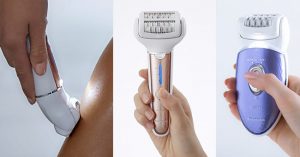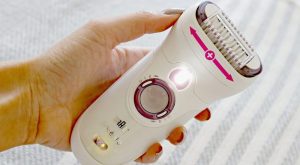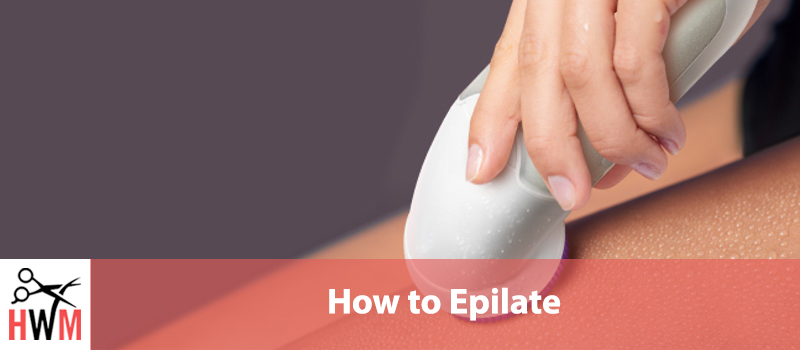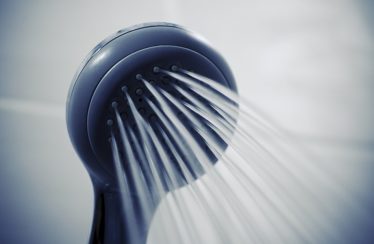Ever watched one of those commercials that show someone, usually a woman, talking about smooth hair-free legs, and thought… if only it were that simple! The truth is hair removal does not have to be a difficult undertaking. With the technology available, removing unnecessary and unwanted hair is easier than ever before, with even better results.
One way to remove hair that is seeing a rapid rise in popularity is epilating. Many people have no idea what an epilator does, let alone how to use one. That is where we come in. We have put together this guide to show you everything there is to know about this unique hair removal method. Epilating can be a great hair removal method for men and women of all ages and works on all hair types.
So, stick around for a full explanation of How to Epilate…
- What is Epilating?
- Preparing to Use an Epilator – First Time User Tips
- How to Epilate – Step by Step
What is Epilating?
In simple terms, epilators use disks or coils to grasp hair just like a tweezer and then pulls the hair removing it entirely, including the root end. The result is that it takes longer for the hair to regrow versus ordinary shaving.
Types of Epilators
No matter which type of epilator you use, they all do the same thing, that is the removal of the entire hair. The differences will be in the way the hair is gripped, and in some cases the way it is pulled away. Some epilators work better for specific types of hair, specifically the thickness of the hair that is being removed.
Spring or Coil Epilators
The first epilators to appear were spring epilators. These epilators are designed with tightly coiled springs that when flexed allowed a small space between each coil. This space allows the hair to enter. When the spring is released it traps the hair between the coils and can then be pulled from the skin. The original epilators we designed to rotate quickly taking the hair with the spin.
Most epilators that use this technology have been replaced with more up to date disc or tweezer epilators. Although there are still a few spring epilators available, particularly the manual version.
Disc Epilators
Disc Epilators we the next type to appear in the evolution of the epilator. The biggest difference with a disc epilator is the increased durability. Instead of compressed coils that wore out quickly, disk epilators use strong rubber discs to do the job. These epilators also seemed to offer a less painful option to the coil ones.
Tweezer Epilators
The newest type and most prominent these days are tweezer epilators. Tweezer epilators work more like traditional epilators with several plates that rotate quickly on an angle, trapping the hair between them as they push together, continuing to rotate they pull the hair, eventually releasing it when the plates move apart again.
Tweezer epilators can have only a few discs, perfect for small, precise hair removal, or several dozen discs; easier for removing hair from larger parts of the body.
Additional Epilator Styles

Though every epilator is going to fit into one of the above types, there are several styles available. The style you choose is going to be determined by your unique hair removal needs and how you plan to use it.
Manual Epilators
Like the name suggests a manual epilator uses no power and is used by hand. These are coil epilators when you bend the coil the hair gets trapped. Releasing the spring, or straightening it traps and pulls the hair away.
The best manual epilator is the R.E.M. Spring Facial Hair Remover. Specifically designed to remove even the finest hairs, including peach fuzz from your face. This epilator is made with 100% stainless steel, so it is safe for anyone to use.
Electric Epilators
Electric epilators are more than just added electricity, they offer a less painful process, and can speed things up removing much more hair in a shorter amount of time. Electric epilators usually have skin guards as well, making it less likely they will pinch the skin as they remove hair.
Cordless Epilators
These days almost every type of grooming device can be cordless, and an epilator is no exception. With a cordless epilator, you are not tied to an outlet, so you have more freedom to be comfortable while you are epilating. Some epilators even have long-lasting rechargeable batteries, perfect for taking with you wherever you go.
A great cordless epilator is the Silk-épil 9 Wet & Dry Cordless Epilator. For a cordless epilator, this one packs a punch, with a wide head and MicroGrip tweezers that can get even the shortest hairs. This epilator can also be used wet or dry.
Corded Epilators
Corded epilators do have their advantages. Luckily most of them have longer cords than other grooming devices. They are also much more powerful than most cordless models. You also never have to worry about not being able to use your epilator due to a dead battery.
The absolute best, corded epilator is the Emjoi AP-18 Emagine Epilator. The only epilator with Silver Ion Technology for antimicrobial protection, this epilator has 72 tweezer heads on two, dual-opposed, staggered heads that work together to remove more hair in half the time compared to most other epilators. This epilator is dry use epilator (see below).
Wet/Dry Epilators
Epilators, like electric razors, can be made either wet or dry use. In general, most epilators should be used when your skin is dry, but warmth can make the whole process less painful, and less irritating to the skin. Therefore, individuals with sensitive skin or skin that is easily irritated will probably want the wet option.
Facial Epilators
Facial epilators are less common that epilators designed for the rest of the body. Few epilators are able to handle the fine hairs on the face or the thicker, coarse hairs of men’s facial hair. Though this is changing. Updated designs are released all the time.
Body vs. Leg Epilators
The funny thing about grooming products, and hair removers, in particular, they are always suggesting where you should use their product and what to avoid. When it comes to epilators there is one major feature you should be aware of regardless of what the packaging claims; how does it affect the skin as it removes the hair.
And really… what is the difference between body hair and leg hair? Aren’t the legs part of the body?
Anyway, when an epilator irritates the skin in anyway you will want to avoid using it altogether not stick to one area there the irritation may not be as bad as another. If irritation occurs, stop using the epilator. On the other hand, we would argue that other than the precise thickness of various hairs, an epilator that protects the skin can be used anywhere, no matter what the packaging says.
Differences Between Men’s and Women’s Epilators
Now for the most important question of all, men vs women, are epilators different, should they be? If so, how?
Want to know the real difference between a men’s epilator (if you can find one) and a women’s epilator… the color of the epilator! That’s right other than the fact that some epilators work best on fine hair and others for thicker hair the only difference is the color stereotype.
In reality, many men find epilators marketed to women to work wonders at removing their unwanted hair and couldn’t care less what the color says.
Advantages to Using an Epilator

Any type of hair removal process is going to have its pros and cons. When it comes to using an epilator that is no different. Some of the advantages of using an epilator for hair removal include:
Disadvantages to Using an Epilator
There are some disadvantages to hair removal by an epilator. Epilators may not be perfect for everyone, and here are the likely reasons why.
Is It Painful?
Everyone has their own individual, so everyone will feel a different level of pain using an epilator. That being said, there are ways to reduce the potential pain you may experience, and we’ll get into that in a little bit.
Individuals afraid of the pain that may come when using an epilator would benefit from an epilator with a more powerful motor, such as a corded epilator. This would make the process less painful by removing the hair more quickly. Just like using a tweezer, if you pull the hair out slowly, you will feel more pain then if the hair is removed very quickly.
Where To Use an Epilator
One of the best things about using an epilator for hair removal is that you can use them anywhere on the body. There are epilators that are designed to offer more precise epilation for areas where you may want to be careful to remove only the hair you want, like around the eyebrows. However, the general way an epilator works is a safe hair removal method for all types of body hair.
When NOT to Epilate
While there are no hard and fast rules that say if you have something going on, you absolutely cannot epilate, there are times when it may not be the best choice for hair removal.
Preparing to Use an Epilator – First Time User Tips

We all remember our first time epilating, and many probably wish we knew a few of these tips ahead of time. While these tips are great for anyone getting ready to epilate, first-time epilators are especially worried about the pain and may actually make it worse without proper preparation.
- Plan Ahead – A couple of days before you plan to use an epilator is a great time to shave. This will help to ensure the proper hair length by the time you use your epilator.
Though it is not mandatory, you will find that it is less painful to remove short hairs then longer hairs. Shaving takes care of any excess length and gives you a chance to examine your skin for any issues to avoid with an epilator. - Exfoliate – 24 hours or so before you plan to epilate, gently exfoliate the skin where you will be removing hair. Not only will this help to eliminate any dead skin that has accumulated; exfoliating is the best way to remove and prevent ingrown hairs!
- Plan to Epilate at Night – There are many reasons that epilating at night can be beneficial. First, most people find it easier to relax late in the evening, relaxation = less pain. Next, during the night as we sleep our skin swells slightly allowing greater blood flow. If you epilate before going to sleep, you will likely wake up redness and inflammation free by morning. Finally, you can take your time. While epilating can be done quickly, you will achieve the best results when you do not have to rush to get to work.
- Take a Pill – Unless you otherwise shouldn’t, taking a Tylenol or Advil approximately 30-60 minutes before you use an epilator can decrease the pain followed by cool compresses after you are done.
How to Epilate – Step by Step
Step 1: Pull the skin taut – This will not only make it easier for the epilator to do its job, but will help to reduce pain, redness, and any irritation.
Step 2: Hold the epilator straight (90 degrees) against the skin. Most epilators are designed two work in this position, hold them at a different angle may decrease the amount of hair removed or even risk pinch the skin while epilating.
Step 3: Move the epilator opposite of hair growth. For example, the majority of leg hairs grow downward, you will be moving the epilator up the leg. We also suggest moving in a small circular motion in areas where the hair may grow in multiple directions
Step 4: Start in areas of more dense hair and move slowly. Going too fast will decrease the number of hairs removed correctly or break hairs off instead of removing them completely. You can go over the same area if necessary, to remove every hair.
Step 5: Moisturize your skin – That’s it, you’ve done it. All you have left to do is clean your epilator and enjoy your hair free, smooth skin.
Conclusion
Over time you will likely notice that the hairs that regrow are finer and grow much slower than before, allowing you to go even longer between epilation sessions. While epilating is not considered a permanent hair removal method, it is perhaps the next best thing.




